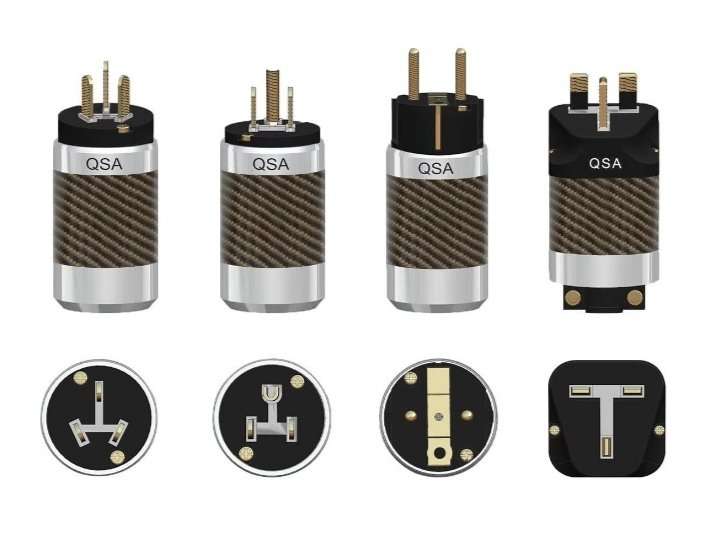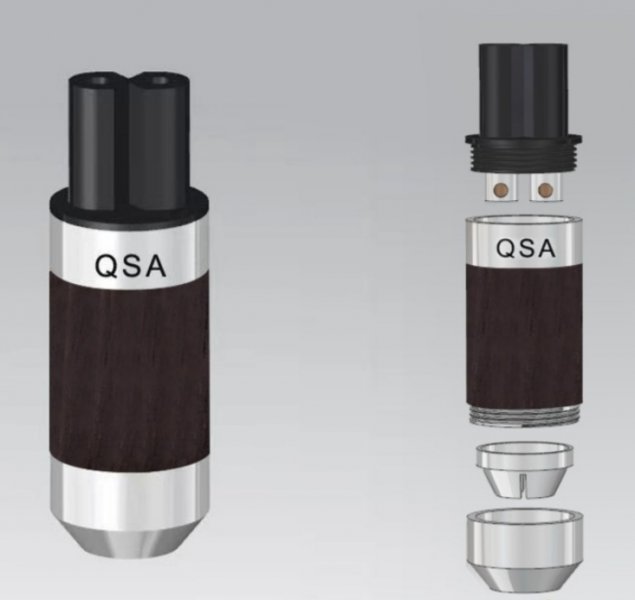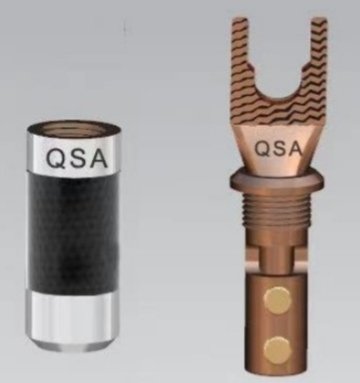QSA : My take on their expensive products
- Thread starter CKKeung
- Start date
You are using an out of date browser. It may not display this or other websites correctly.
You should upgrade or use an alternative browser.
You should upgrade or use an alternative browser.
So, if you currently have a Power conditioner, do you still use that before plugging it into the ultra-expensive duplex outlet? I currently have SR orange Duplex outlets. I have my two mono amps plugged directly into the wall outlet and the DAC and Music server into the Power conditioner which then goe to the SR orange Duplex.
I wonder what makes the most sense? Are you defeating the purpose of a $5k duplex if you don't go directly to the outlet? Given that I already have upgraded outlet boxes and really don't know if they make a difference, I also wonder if it is worth it to upgrade to the RED QSA outlets? Where is the law of diminishing returns?
I wonder what makes the most sense? Are you defeating the purpose of a $5k duplex if you don't go directly to the outlet? Given that I already have upgraded outlet boxes and really don't know if they make a difference, I also wonder if it is worth it to upgrade to the RED QSA outlets? Where is the law of diminishing returns?
So, if you currently have a Power conditioner, do you still use that before plugging it into the ultra-expensive duplex outlet? I currently have SR orange Duplex outlets. I have my two mono amps plugged directly into the wall outlet and the DAC and Music server into the Power conditioner which then goe to the SR orange Duplex.
I wonder what makes the most sense? Are you defeating the purpose of a $5k duplex if you don't go directly to the outlet? Given that I already have upgraded outlet boxes and really don't know if they make a difference, I also wonder if it is worth it to upgrade to the RED QSA outlets? Where is the law of diminishing returns?
With regard to the fuses, there is a big difference in sound quality between the red and silver. The reports I have seen by trusted friends say the silver outlets are much better than the red (and black-red) outlets.
If you think your power conditioner benefits from the orange duplex, there is no reason to believe it won't benefit even more from a silver outlet. It's possible you might get the biggest benefit plugging your mono amps directly. You would have to assess the best configuration once you have one installed in your setup.
With regard to the fuses, there is a big difference in sound quality between the red and silver. The reports I have seen by trusted friends say the silver outlets are much better than the red (and black-red) outlets.
At four times the price for the fuses, there better be a big difference.
At four times the price for the fuses, there better be a big difference.
To your original question, there is no sense of diminishing returns when going from red to silver.
For me, assuming the Reds I receive are what’s claimed, is the difference between Red and Red/Black.
For me, assuming the Reds I receive are what’s claimed, is the difference between Red and Red/Black.
I have no experience with the jump from red to red-black.
With regard to the fuses, there is a big difference in sound quality between the red and silver. The reports I have seen by trusted friends say the silver outlets are much better than the red (and black-red) outlets.
This is what I have been told by three different people who have made this move. It is possible we have spoken to the same person. FWIW I have my entire system fed by this outlet, hence 'global' benefit and will next look at the breakerbox options.
Thanks Peter, we might be on the same whatsapp group and I have logged an order for samples to evaluateNew products of QSA?
Will be launched in a few weeks' time?
View attachment 92517
View attachment 92518
View attachment 92519
FWIW I have my entire system fed by this outlet, hence 'global' benefit and will next look at the breakerbox options.
Is QSA now offering circuit breakers?
I see them but there is no information about them. I tried clicking on the pictures. I wonder what they cost? It looks like there are various levels as well. I assume they would be certified for use in USA or wherever.
Before spending so much money on fuses, I wonder how many users had actually measured the electric phase of their equipment to make sure they are all wired correctly ? I suspect this would make a much larger difference than any fuse could. The grounding scheme is also very important. I star ground all the equipment to a common ground via a balanced isolation transformer. If you have already done all that and still find a difference with the expensive fuses, go for it.
Can you please provide more information on what balanced isolation transformer you use and what it actually does? Also, sorry but what does star ground mean.Before spending so much money on fuses, I wonder how many users had actually measured the electric phase of their equipment to make sure they are all wired correctly ? I suspect this would make a much larger difference than any fuse could. The grounding scheme is also very important. I star ground all the equipment to a common ground via a balanced isolation transformer. If you have already done all that and still find a difference with the expensive fuses, go for it.
Only $6,500? I am speechless. Do you get a discount if you buy more than one?Sorry, I’ve made a mistake
Receptacles are only up to $6,500 USD
Fuses are up to $10,000 USD
Single phase mains supply often has the neutral tied to ground. That means the voltage swings from 0 to 340V (for 120V mains) instead of -170V to +170V. The electric phase of the power supply of hi fi equipment is not standardised. If you use a cheater plug (a two-prong plug that you can plug in either orientation), you will find that the chassis ground of your equipment has a different voltage potential relative to mains ground when you change the plug orientation. If all your hi fi equipment has random electric phasing, there will be current going through the signal ground from the equipment with the higher ground potential to the ones with the lower ground potential. This is one of the causes of ground loop. To avoid this problem, you can measure the chassis ground voltage using the cheater plug, and wire the plug at the orientation that produces the lower potential. You can also use a balanced isolation transformer. The transformer recreates a new ground at the center tap of the secondary winding, so that the voltage swings from -170V to +170V. All the equipment plugged into the transformer will have the same ground potential at 0V. Any noise that enters the live and neutral wires get cancelled since the power comes from the difference between the two wires. A well balanced system can have a common mode noise rejection of up to -60dB (1/1000th). I find this to be by far the most effective noise suppression method, much more so than other noise suppression schemes. Plugging all the equipment directly into the one transformer also forms a star ground, since all the equipment ground goes directly to the transformer. You get into trouble if you plug the different components into different electrical outlets, which might have different ground potentials.Can you please provide more information on what balanced isolation transformer you use and what it actually does? Also, sorry but what does star ground mean.
Would an isolation transformer eliminate a slight hum in the speakers from a tube amp?Single phase mains supply often has the neutral tied to ground. That means the voltage swings from 0 to 340V (for 120V mains) instead of -170V to +170V. The electric phase of the power supply of hi fi equipment is not standardised. If you use a cheater plug (a two-prong plug that you can plug in either orientation), you will find that the chassis ground of your equipment has a different voltage potential relative to mains ground when you change the plug orientation. If all your hi fi equipment has random electric phasing, there will be current going through the signal ground from the equipment with the higher ground potential to the ones with the lower ground potential. This is one of the causes of ground loop. To avoid this problem, you can measure the chassis ground voltage using the cheater plug, and wire the plug at the orientation that produces the lower potential. You can also use a balanced isolation transformer. The transformer recreates a new ground at the center tap of the secondary winding, so that the voltage swings from -170V to +170V. All the equipment plugged into the transformer will have the same ground potential at 0V. Any noise that enters the live and neutral wires get cancelled since the power comes from the difference between the two wires. A well balanced system can have a common mode noise rejection of up to -60dB (1/1000th). I find this to be by far the most effective noise suppression method, much more so than other noise suppression schemes. Plugging all the equipment directly into the one transformer also forms a star ground, since all the equipment ground goes directly to the transformer. You get into trouble if you plug the different components into different electrical outlets, which mighave different groundpotentials.
There's hum and hum. Jim Smith, well known audio set up guru, commented some years ago that in his vast experience dead silent systems invariably sound worse than ones with a little (close up) noise.
This depends on the source of the hum. If the hum is 60hz, it is most likely coming from the tube heaters (assuming you have AC heating, which is common for amps that use directly heated triodes). If it is 120hz, it is coming from the high tension power supply. This might be a problem with the power supply design, or the filter caps need to be replaced. If the hum is from a ground loop, the isolation transformer will help. If you disconnect the input signal cables and the hum is still there, it is not from a ground loop.Would an isolation transformer eliminate a slight hum in the speakers from a tube amp?
Maril555 said:
Sorry, I’ve made a mistake
Receptacles are only up to $6,500 USD
Fuses are up to $10,000 USD
Those are not the USD figures on the QSA site.
Sorry, I’ve made a mistake
Receptacles are only up to $6,500 USD
Fuses are up to $10,000 USD
Those are not the USD figures on the QSA site.
Last edited:
Similar threads
- Replies
- 31
- Views
- 3K
- Replies
- 865
- Views
- 175K
- Replies
- 50
- Views
- 12K
- Replies
- 0
- Views
- 1K
| Steve Williams Site Founder | Site Owner | Administrator | Ron Resnick Site Owner | Administrator | Julian (The Fixer) Website Build | Marketing Managersing |




